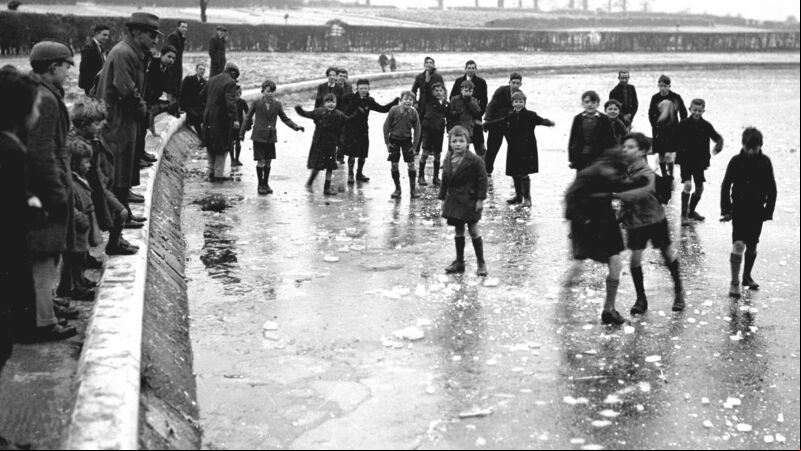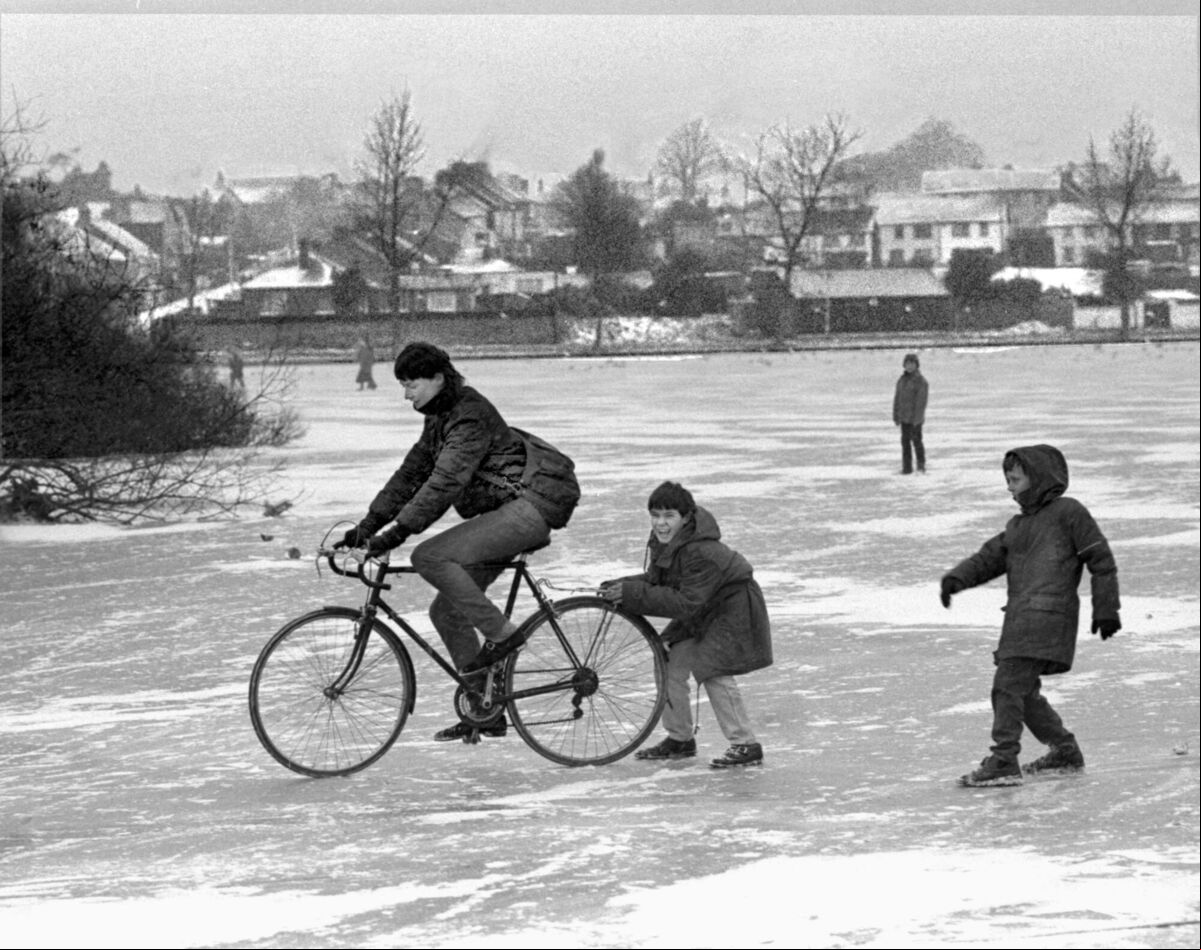Pictures: Do you any of these bitter winters from decades past in Cork?

Skating on The Lough, December 1937.






Skating on The Lough, December 1937.
For all of its slightly overdue Christmas card beauty and happy memories for children, sneachta won’t be missed by most of us when temperatures return to seasonal norms.
The cold weather has caused a lot of hardship and misery across the country and county, and many people will welcome báisteach if it brings milder weather.
Although temperatures have been bitterly cold all week and much of the county has been blanketed in snow, Cork city escaped the worst of it.

Still, even if the snow didn’t stay long on the ground, the gulls and moorhens were regularly seen waddling on thin sheets of ice floating on The Lough this week, bringing to mind some of the coldest winters on record.
The freezing of The Lough has previously happened during weather events that have stayed in Cork’s folk memory as markers of bad winters past. At least once, city authorities broke up the ice on The Lough for fear of the safety of the public and wildlife.
In 2010, The Lough froze over and children and adults played on it for weeks, and although Cork City Council erected notices warning people against walking on the ice, nobody paid too much heed.

It had also frozen over 23 years earlier, in January, 1987, as Arctic conditions gripped the whole country, and for weeks The Lough was a playground for young and old alike.
Across the city, public-transport schedules were thrown in to disarray, with road conditions treacherous.
In the Evening Echo, on Monday, January 12, the Southern Health Board appealed to the public to look in on elderly neighbours. The Echo reported that, “The Lord Mayor, Cllr Gerry O’Sullivan, also called on the public to help elderly neighbours through the cold spell.”
Mr O’Sullivan said: “The elderly may be short of food, fuel, money, or just company. If any old people are living nearby, I ask that they be visited and looked after in what could be a terrible time for them.”
Edward O’Connor, of the Cork Society for the Prevention of Cruelty to Animals, appealed to the public to feed birds.

Food for birds, he said, should be placed at an elevated height, where dogs and rats could not get at it, and he recommended “a cake made of oatmeal and dripping, which, while being inexpensive to make, contained most of the protein required by birds”.
Two days later, beside a Maurice O’Mahony photograph of children playing on the ice on The Lough, we reported that birds, struggling to take flight in the bitter cold, were being terrorised by roaming dogs, and Mr O’Connor appealed that owners keep their dogs on a leash.
“Additional worry is also provided as youngsters take to The Lough surface,” we reported. “Some have even been seen riding bicycles on the ice!”
The following evening, the mood was more sombre, as our front-page story read: “Children who have been skating on the frozen surface of ponds and lakes around the country have been dicing with death, the gardaí warned today.”
It came the day after two 16-year-old boys had fallen through ice and drowned in freeing water in Co Mayo.
Cork city engineer Liam Fitzgerald was quoted as saying the corporation had despatched workmen to The Lough at first light. “We have a JCB there this morning, breaking the ice in order to stop children playing on the surface and also to help the wildlife.”
A decade earlier, the winter of 1977 in to 1978 was also bitterly cold, with significant snowfalls in the south and south-east of the country.
In February of 1978, there was 26cm of snow at Cork Airport, the greatest depth recorded at that weather station.

The winter of 1947 remains the harshest recorded in Ireland. In the three months from January 19 to March 15, an Arctic cold snap led to five major blizzards and caused many deaths across the country.
With temperatures barely rising above freezing for weeks on end, the snow remained thick on the ground and in the 50 days from January 25 to St Patrick’s Day, 30 saw snowfall.
The worst day of that period was ‘The Blizzard’, as it would be ed, which occurred on February 25 and was responsible for the greatest single snowfall on record and which lasted for almost 50 hours, smothering the entire island.
The next day, the front page of the Evening Echo reported: “The Country’s Communications Dislocated, Buses Held In Snow”.
“While most of Munster today enjoyed occasional glimpses of sunshine and comparatively mild conditions, the blizzard effects continued to be felt throughout the Midlands and large areas of the West. Internal communications remain held up and telegraphs and telephones are still dislocated.
“In Dublin city, traffic is back to normal but County Wicklow is completely isolated. Three buses are stuck in the snow on the Dublin-Wicklow road, but in most parts of County Wicklow the electric current has been restored.”
Beside it, a grim local story said: “Sheep owners on the mountain ranges to the south of Millstreet state that more than a thousand sheep have been lost in the snow, which swept these districts during the past month.
“This, they state, is not the full extent of their loss, for many of the black-horned baldy mountain breed that survive usually die off in April, as a result of the hardships though which they at this period.
“Millstreet schools, which were reopened on Monday, were again closed on Tuesday, owing to a heavy fall of snow in the early morning. This turned the roads and streets in to a quagmire of slush and the children who reached the schools had a forlorn, miserable appearance.”

With Met Éireann cautiously forecasting a slow thaw this weekend, people across the county and country are being urged to continue to drive with caution, and to look out for those who might need a little help or a friendly call.
Keep up-to-date with the top stories in Cork with our daily newsletter straight to your inbox.
Please click here for our privacy statement.
2 minutes ago
Justice Minister voices concern over time taken to find Tina Satchwell’s body2 minutes ago
Division 1 FL: Cill na Marta take down 14-man Newcestown with Seán Ó Foirréidh on formone minute ago
Cork hurling fans kept the faith and this team delivered a Munster title victory for the ages47 seconds ago
New flights from Cork to Antalya will take off next MayHave you ed your FREE  App?
App?

It's all about Cork!
46 minutes ago
Man (26) jailed for sexual assault of a woman in a park in Co Donegal3 hours ago
Child (7) dies after suffering ‘sudden heart condition’ on bouncy castle4 hours ago
Irish woman ‘in fear’ ahead of release of Christian Brueckner4 hours ago
Kerry house with spectacular views overlooking Kenmare HarbourAdd Echolive.ie to your home screen - easy access to Cork news, views, sport and more